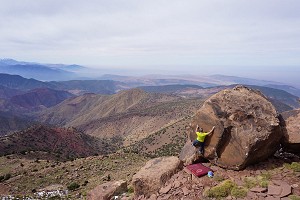
Like Webster's Dictionary............. Acupuncture works. I lost a stone with regular treatment every day for a week. It wasn't voluntary mind you. You just can't avoid being pricked and poked by impressive cacti and other sharp objects if you climb in Morocco. But it's worth it. Perhaps on reflection it was the heat and exercise that got my weight down but I was still picking needles out a week later.
It was seriously hot. Last year, Ken and John had nice British Summer type temperatures and wore jumpers on the crags and fleeces in the Amandiers Hotel. This year we could have left all that gear behind. I found it hard work climbing 6 days in a row. I turned 58 while out there but on the day felt as if I'd turned 70. My mutterings about a possible rest day didn't bear fruit but I enjoyed it all in retrospect.
We were following those aged pioneers from a bygone age who seem to have given up proper climbing (doing the likes of Surplomb in the snow in nailed boots) and now give their ancient joints a regular Winter warming in the sun around Tafraoute in the Moroccan Anti-Atlas. According to the locals, many of these old-timers were around while we were or had just passed through the day before.
Carpet-seller: "Do you know that Mr John Brown – he bought a carpet here. Very good carpet – you come visit my exposition? Come! Come!"
Mr Sabir of Chez Sabir restaurant: "Mr climbing guide book writer – he ate here yesterday. He always eats here."
It seemed we were just missing all these famous names from all our yesteryears. The reference to "John" Brown led us into a flight of fancy about who else we might have missed: Chris(tian) Turlington perhaps or even Paul "Jonathan" Woss. But we would have liked to meet Claude Davies to say thanks for sharing the old guys' experiences in his Cicerone guide to the Moroccan Anti-Atlas.
It's the perfect antidote to guides that offer soulless,clip clip, lower off, put brain in neutral, sport climbing. Here, you drive up and down the valley road until you find the point the crag photo was taken from and keep that image in mind as you start up the stony, spikey hillside. Provided you get to the foot of the right crag (last year a party searched unsuccessfully all day for Crag U apparently) locating the climbs proves straightforward. You get no description or pitch lengths – just a line on the photo - and the only grade offered is the hardest move. It could all be 5a or just one move on the whole climb. That keeps you on your toes and leads to a fair amount of jockeying for position either to bag (or more often to try and avoid) the harder leads.

The guide has been written to retain as much of the adventure as possible and it works. There are no bolts, pegs or fixed gear. Natural gear is pretty good overall but we found some big stuff quite handy. Most descents are walk-offs so no need for much extra abseil tat. We came across a couple of slings all week and saw no other climbers at all – even the old guys.
We didn't do anything very hard but you wouldn't want to take a bunch of novices out there. The climbs are typically 200-350 metres and some experience to cope with route-finding and climbing into the unknown - sometimes quite a distance from gear - is desirable. Athough the BMC insurance for Europe covers Morocco, it won't be much use to you. Self rescue would be probably be the order of the day. The old adages about the leader never falling and keeping 3 points of contact (or as you pass a cactus – 17 points) seem very much in point.
The rock is a beautiful pale solid quarzite. Why go on the long haul to Mt Arapiles when you have all these bigger almost virgin cliffs a short Airtours hop away. And there's endless scope for new routing.
The local people were very welcoming. Western women were perfectly safe but some concession to local sensitivities seems only polite as the local women do cover up. German women tourists wearing shorts and with lots of flesh on show just looked out of place although they seemed completely oblivious.
Tafraoute is self contained and the local economy seems to work. There's a lot of building going on and houses still spring up in villages miles from anywhere. Take Anergui for example. A dirt road became a concrete version during the last year and leads excitingly high up into the mountains and Crag A looms over this tiny village. Very slowly one further house is being built. The two men "working" on it and a couple of other residents together with a pack of friendly dogs were all called to prayer several times during the course of our first climbing day. We got used to the siren like recordings echoing across the valleys and it gave an other-worldly quality to the climbing experience. Nearer my God to thee perhaps.
Back in Tafraoute the traders were a hoot. As soon as you park they seem to emerge from the ground like in those voodoo scenes in Live and Let Die. Promises of bargains began to sound like threats and it is difficult to resist a visit to various "expositions". Once there it is even more difficult to resist buying a rug you know you don't really need or want. John succumbed not just to a rug but a pouffe (make of that what you will!). French is useful by the way if your Arabic is rusty.
Shoemaker's alley is great. Ken had to go back this year because his dog ate his last pair of leather slip-ons. In theory it's yellow for men and red for women but I settled for a tasteful beige unisex approach. A bit of haggling goes down well. The jewellery looked good but it was impossible to tell how much gold or silver you might be getting. Nevertheless, Jim loaded up to make sure he would be allowed out again.

Eating out is basically beef or chicken tagine with or without almonds or prunes. Tasty but a bit samey after a while. If you want a drink in this strictly Moslem country then the Amandiers Hotel serves wine and beer. One of life's strange coincidences meant that this was where we chose to stay for the week. The tented restaurant in town also serves wine. Otherwise its (bottled) water or delightful mint tea sweetened with local honey.
In climbing terms we climbed on crags A (in the West), F, J, U and W (to the East). Best climbs were Stairway to Heaven (Crag A), Spacewalk (Crag W), White Tower (Crag U) and, on the last day, the Lion's face on Crag J. The Lion's face shows up clearly in the late afternoon sun and the route traces a line up past its nostrils on the left, turning the overhangs to the right of its right eyebrow. Most of it is quite easy but it's a great outing with complex route-finding to get to the start and a fantastic and long walk and scramble off the top.
Settling up at the hotel should have been a doddle using our plastic. Mysteriously however, exactly as Ken and John found last year, the Visa machine broke down just at the wrong moment. We managed to scrabble together an assortment of local Dirham and very acceptable Euros and thus avoided having to leave Jim behind as compensation. There is a cash machine in town by the way which I'm sure will be working even when the Visa link up just up the hill is allegedly down.
On our drive out on the Sunday we took the southern route back to Agadir. We passed some seriously big crags not mentioned in any guide but I expect "John Brown" and his pals have knocked off all the good lines already and just kept it secret. Christy Turlington-Bonington clearly doesn't know about them yet as they don't get a mention on his website. Don't tell him! It's our secret.
Back at Gatwick at 3 in the morning my sack was being hurled around by the coach driver. A screech split the air. "Oy mate - have you got a hypodermic in that sack?" The curse of the acupuncturist struck again. I expect to be picking spines out of my gear for some time to come.
GUIDEBOOK: Climbing in the Moroccan Anti-Atlas by Claude Davies published by Cicerone.
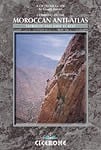
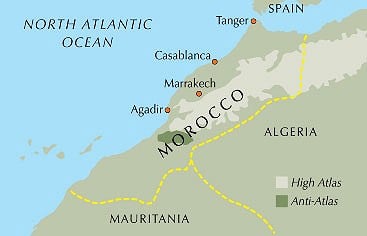
However, it is not a place for the novice. Many of the crags are complex, and route finding can be difficult. Descents occasionally involve abseils and down-climbing in exposed situations. The weather is rarely inclement and, even when it is, it is unlikely to involve electrical storms.
Price £12.00: Buy here at: www.cicerone.co.uk
- Also read Moroccan Rock by Guy Robertson at www.mountaineering-scotland.org.uk
- Survival Guide to Climbing in Moroccan Anti-Atlas and another trip report by Steve Broadbent, with several excellent downloadable topos at sjbroadbent.googlepages.com/morocco
- General information about the Ameln Valley here at lexicorient.com
Malcolm Phelps is 58 years old. Been climbing since 1968. Brought up on the Avon Gorge. High points in cragging were Krapp's Last Tape and the Medlar with Jim Unwin in 1975 but nothing more than E2 since! Favourite UK area is Pembroke. Scariest climb Preposterous Tales. Most recent harder route Deep Space which I led in appalling style earlier this year. In recent years the four of us from way back - Jim Unwin, Ken Goodman and John Dennis have managed a Summer week or two's trip to places like Yosemite, Pyrenees, Picos de Europa, Dolomites and Swiss Granite. We're after the big mountain rock routes but not averse to clipping the odd bolt or seven and then having a good moan about how safe it all is these days.
You can read, Third Time Lucky - Cassin Route on the North East face of the Piz Badile by Malcolm Phelps at UKClimbing.com articles

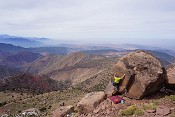
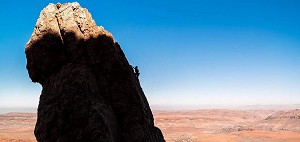


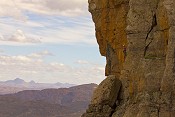



Comments